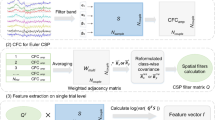Abstract
The miniaturized Electroencephalography (EEG) modules monitors the EEG signals over a smaller area, however, thus modules suffer from poor spatial coverage. The wireless EEG sensor network (WESN) provides an improved spatial coverage with multiple EEG modules, which communicated through a shorter distances. Further, the miniaturized EEG modules tend to create a high energy cost in wireless communication. This paper aims to remove the eye blink artifacts from the WESN EEG channels. The exploitation of correlation among the signals from various EEG modules is taken into consideration for resolving the problem of artifact removal in stringent bandwidth constraints. In this paper, Hessian multi-set canonical correlations based algorithm is used that computes optimal linear combination of the EEG signal between the local EEG channels and other modules. This correlation makes the EEG signal to be correlated at a maximum rate. The use of Hessian multi-set canonical correlations to remove the eye blink artifacts in a distributed realization reduces the transmission cost in the network. The proposed method has been validated against the real and synthetic EEG datasets, collected from the WESN shortest distance communication. The removal of redundant data from the wireless nodes, the algorithm attains an improved performance to remove the eye blink artifact with reduced power consumption in the wireless networks.





Similar content being viewed by others
References
Casson, A. J., Yates, D. C., Smith, S. J., Duncan, J. S., & Rodriguez-Villegas, E. (2010). Wearable electroencephalography. IEEE Engineering in Medicine and Biology Magazine, 29(3), 44–56.
Sun, M., Jia, W., Liang, W., & Sclabassi, R. J. (2012). A low-impedance, skin-grabbing, and gel-free EEG electrode. In Engineering in Medicine and Biology Society (EMBC), 2012 annual international conference of the IEEE (pp. 1992–1995). IEEE.
Bertrand, A. (2015). Distributed signal processing for wireless EEG sensor networks. IEEE Transactions on Neural Systems and Rehabilitation Engineering, 23(6), 923–935.
Grech, R., Cassar, T., Muscat, J., Camilleri, K. P., Fabri, S. G., Zervakis, M., et al. (2008). Review on solving the inverse problem in EEG source analysis. Journal of NeuroEngineering and Rehabilitation, 5(1), 25.
Blankertz, B., Dornhege, G., Krauledat, M., Müller, K. R., & Curio, G. (2007). The non-invasive Berlin brain–computer interface: Fast acquisition of effective performance in untrained subjects. NeuroImage, 37(2), 539–550.
Nazarpour, K., Wongsawat, Y., Sanei, S., Chambers, J. A., & Oraintara, S. (2008). Removal of the eye-blink artifacts from EEGs via STF-TS modeling and robust minimum variance beamforming. IEEE Transactions on Biomedical Engineering, 55(9), 2221–2231.
Noureddin, B., Lawrence, P. D., & Birch, G. E. (2012). Online removal of eye movement and blink EEG artifacts using a high-speed eye tracker. IEEE Transactions on Biomedical Engineering, 59(8), 2103–2110.
Corsini, J., Shoker, L., Sanei, S., & Alarcón, G. (2006). Epileptic seizure predictability from scalp EEG incorporating constrained blind source separation. IEEE Transactions on Biomedical Engineering, 53(5), 790–799.
Khatun, S., Mahajan, R., & Morshed, B. I. (2016). Comparative study of wavelet-based unsupervised ocular artifact removal techniques for single-channel EEG data. IEEE Journal of Translational Engineering in Health and Medicine, 4, 1–8.
Mahajan, R., & Morshed, B. I. (2015). Unsupervised eye blink artifact denoising of EEG data with modified multiscale sample entropy, kurtosis, and Wavelet-ICA. IEEE Journal of Biomedical and Health Informatics, 19(1), 158–165.
Guerrero-Mosquera, C., & Navia-Vázquez, A. (2012). Automatic removal of ocular artefacts using adaptive filtering and independent component analysis for electroencephalogram data. IET Signal Processing, 6(2), 99–106.
Ting, C. M., Salleh, S. H., Zainuddin, Z. M., & Bahar, A. (2014). Artifact removal from single-trial ERPs using non-Gaussian stochastic volatility models and particle filter. IEEE Signal Processing Letters, 21(8), 923–927.
Dammers, J., Schiek, M., Boers, F., Silex, C., Zvyagintsev, M., Pietrzyk, U., et al. (2008). Integration of amplitude and phase statistics for complete artifact removal in independent components of neuromagnetic recordings. IEEE Transactions on Biomedical Engineering, 55(10), 2353–2362.
Constantin, I., Richard, C., Lengelle, R., & Soufflet, L. (2006). Nonlinear regularized Wiener filtering with kernels: Application in denoising MEG data corrupted by ECG. IEEE Transactions on Signal Processing, 54(12), 4796–4806.
Shoker, L., Sanei, S., & Chambers, J. (2005). Artifact removal from electroencephalograms using a hybrid BSS-SVM algorithm. IEEE Signal Processing Letters, 12(10), 721–724.
Shao, S. Y., Shen, K. Q., Ong, C. J., Wilder-Smith, E. P., & Li, X. P. (2009). Automatic EEG artifact removal: A weighted support vector machine approach with error correction. IEEE Transactions on Biomedical Engineering, 56(2), 336–344.
Vigon, L., Saatchi, M. R., Mayhew, J. E. W., & Fernandes, R. (2000). Quantitative evaluation of techniques for ocular artefact filtering of EEG waveforms. IEE Proceedings-Science, Measurement and Technology, 147(5), 219–228.
Wu, J., Ifeachor, E. C., Allen, E. M., Wimalaratna, S. K., & Hudson, N. R. (1997). Intelligent artefact identification in electroencephalography signal processing. IEEE Proceedings-Science, Measurement and Technology, 144(5), 193–201.
Bertrand, A., & Moonen, M. (2015). Distributed canonical correlation analysis in wireless sensor networks with application to distributed blind source separation. IEEE Transactions on Signal Processing, 63(18), 4800–4813.
Bertrand, A., & Moonen, M. (2014). Distributed eye blink artifact removal in a wireless EEG sensor network. In 2014 IEEE international conference on acoustics, speech and signal processing (ICASSP) (pp. 5849–5853). IEEE.
Author information
Authors and Affiliations
Corresponding author
Ethics declarations
Conflict of interest
The authors declare that they have no conflict of interest.
Ethical Statement
This article does not contain any studies with animals performed by any of the authors.
Additional information
Publisher's Note
Springer Nature remains neutral with regard to jurisdictional claims in published maps and institutional affiliations.
Rights and permissions
About this article
Cite this article
Manojprabu, M., Dhulipala, V.R.S. Power Aware Hessian Multi-set Canonical Correlations Based Algorithm for Wireless Eeg Sensor Networks. Wireless Pers Commun 117, 2745–2756 (2021). https://doi.org/10.1007/s11277-020-07045-3
Published:
Issue Date:
DOI: https://doi.org/10.1007/s11277-020-07045-3




